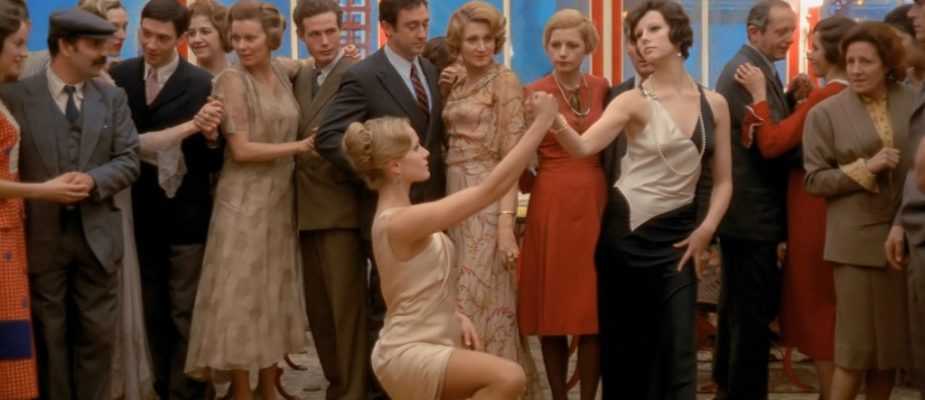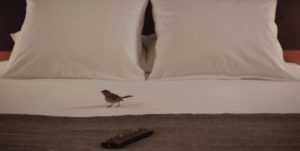When first I wrote about Bernardo Bertolucci’s The Conformist (Il conformista, 1970) more than nine years ago – in a piece from which I am about to self-plagiarize shamelessly – I lamented the film’s longstanding absence from home video, save for the dubbed video cassettes that provided many a young film-lover’s (wholly inadequate) introduction to this colossus of world cinema. Though it is great news, therefore, that the film finally will be released on Blu-Ray later next month, even better is the fact that Bertolucci’s masterwork is currently touring in a newly restored 4-K print, which will screen twice at the Oklahoma City Museum of Art on October 17 (at 5:30 p.m.) and October 19 (at 2:00 p.m.). The Conformist, after all, is the quintessential big-screen art film: it is a work of overwhelming visual poetry made in an era of ravenous and discerning communal film viewership. To see The Conformist more than forty years on is to be transported not only to the fascist Italy of the film’s a-chronological narrative, but to a bygone age of art-houses and cine-clubs; to that time, before the rise of quality television (and the more recent phenomenon of binge-watching), when movies mattered most. This is not the film to watch on a 17-inch computer screen or even in the isolation of one’s state-of-the-art home theater. This is a film to see much larger than life, in all its overblown opulence, seated behind that budding OCU cinephile or across from that beautiful twenty-something – who might just be Italian too. To really experience The Conformist is to be transported nostalgically back to the glory days of the European art cinema.
From the flashing neon of the opening credits (and yes, this is where my self-plagiarism begins), The Conformist is awash in visual ideas. Or, more precisely, so begins its endless index of indelible images. There is perhaps no final rule for Bertolucci and legendary cinematographer Vittorio Storaro’s visual strategy other than that will it lean heavily on the unforgettable – be it a whitewashed roof-top asylum, Jean-Louis Trintignant walking alongside a vintage automobile in a canted (off-kilter) composition, fallen leaves swept up by a sudden gust, the beautiful Stefania Sandrelli dancing with the even more gorgeous Dominique Sanda (see pictured), or the latter pounding on Trintignant’s automobile window as he looks on impassively. The Conformist, in short, is the sum of its visual highlights; of its series of picture-perfect compositions that immediately announces its twenty-nine year-old filmmaker’s considerable visual artistry.
It’s not only been nine years since I wrote about The Conformist; it’s also been nine years since I last saw The Conformist – meaning that I will be eager to gauge my viewing experience as a mid-thirty-something (vs. my opinion in my mid twenties, on what I believe was a second viewing). While I imagine that the shot-for-shot power of the film will remain as monumental as ever, I do wonder whether I will continue to experience the slightest of disappointments when it comes to the film’s overtly Freudian explanation for Marcello’s (Trintignant) behavior. Then again, perhaps I will be able to take it a bit more for granted this time, as the (late sixties) historical and intellectual product that it clearly is, not to mention as the impossibly ambitious work of youthful brilliance that has earned the film, and its rationalizing flashback structure, its many comparison to Citizen Kane (1941)? (Though one of the greatest works of the classical period – period! – Kane is also subject to scrutiny on the level of its psychological assessment, to risk cinematic heresy.) Either way, The Conformist is the film to see in Oklahoma City this weekend, a work of such overwhelming filmmaking prowess and visual grace, that it is certain to be a revelation whether you are one of the lucky ones seeing it for the first time, or whether instead you’ll be remaking The Conformist’s impossibly attractive acquaintance on 4-K digital.
In last week’s post, I said of Pascale Ferran’s Bird People (2014) that it is “that almost quintessential example of a film about which the less said the better.” (More self-plagiarism, I know.) Though that is certainly the case when it comes to the film’s story – and since you’ve all now seen it, I will not worry about avoiding spoilers from this point forward – the same cannot be said for its references and its ideas about class. To speak to at least one important source first, Bird People joins last week’s other feature, Ramon Zürcher’s superlative The Strange Little Cat (2013), as a work that draws on the films of Jacques Tati – and in the case of Ferran’s film, Playtime (1967) specifically. Indeed, as in Tati’s career-defining (and destroying) masterpiece, Ferran sets her film in a decidedly un-picturesque Paris, on the capital’s commercial edges where the Eiffel Tower is glimpsed only once during the film’s two-hour duration. In this very liminal, transitional space, Ferran makes the same use (as Tati) of transparent exterior glass in order to depict a sea of disconnected persons and groups, as they spend their time isolated in Bird People’s airport hotel. With Bird People, however, the point is less the alienating effects of the architecture itself, than it is the class imbalance that manifests itself between the hotel patrons and our titular sparrow – not to mention the loneliness which our two heroes share.
Expanding on Bird People’s Biblically marked class consciousness (i.e. consider the sparrow), Gary’s (Josh Charles) escape in Ferran’s film is very different than Audrey’s (Anaïs Demoustier), because he can afford simply to leave everything, to stay on in Europe on a whim. The same, however, is not true for college drop-out Audrey who instead escapes into a sort of fantasy – which is not to suggest that fairy tail transformation does not also occur in the film. The point is that her economic status insures that her escape must come on another narrative level, in the realm of the fantastic, rather than in the shape of everyday reality (as will be true for Gary). Or, as the final scene further infers, possibly in the form of a new love.











